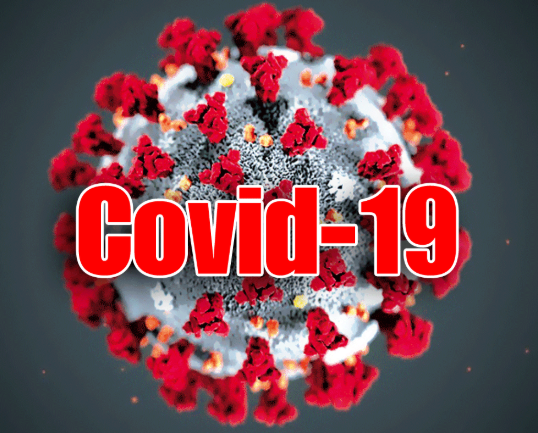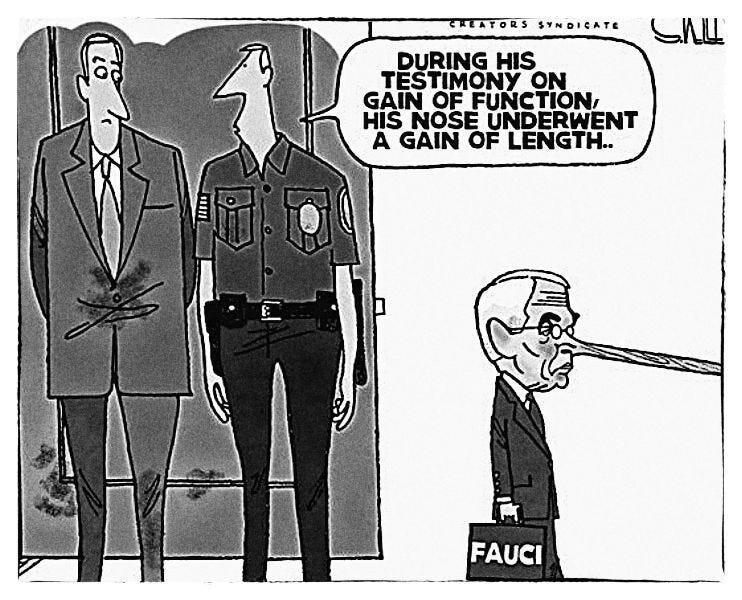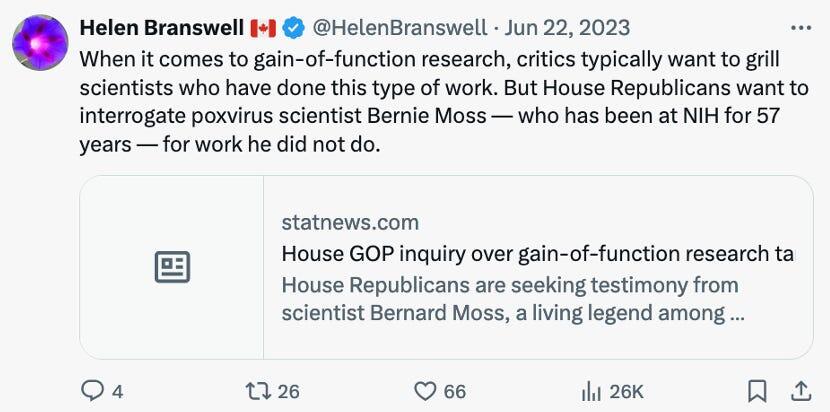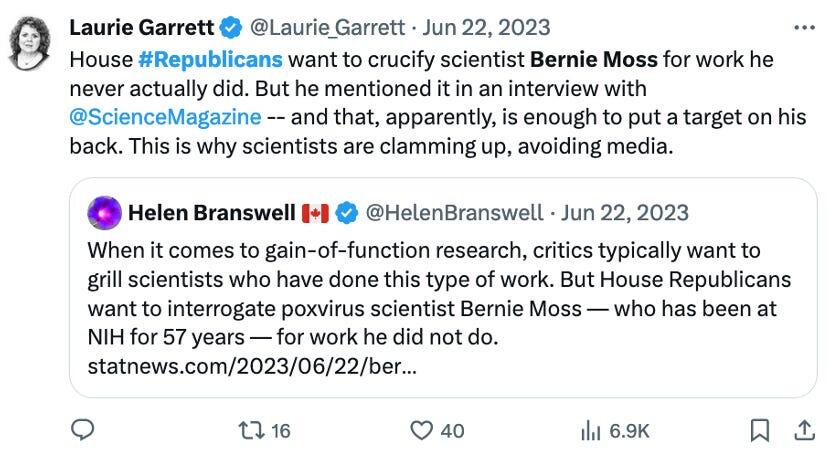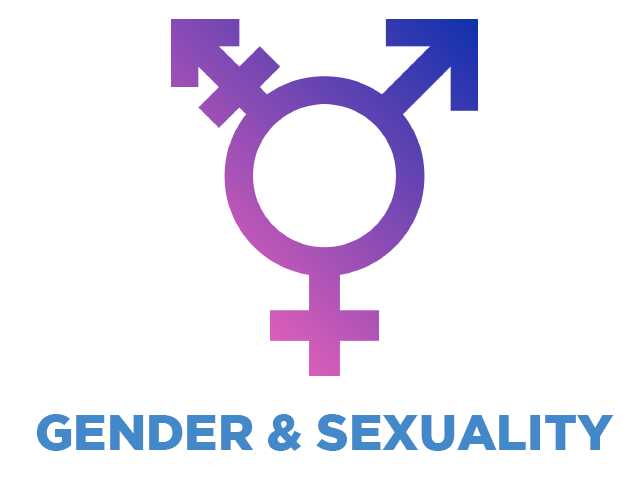NIH Was Feeding Gain-Of-Function Disinfo To Journalists: Documents
Authored by Paul D. Thacker via The Disinformation Chronicle,
House investigators on the Energy and Commerce Committee released a 73-page report yesterday documenting NIH officials lying about dangerous gain-of-function virus research to reporters and withholding information from Congress. These latest revelations follow reporting last week that Tony Fauci lied to the New York Times about his involvement in a Nature Medicine piece that advanced the theory that the pandemic could not have started in a lab Fauci himself was funding in Wuhan, China.
The House began the investigation following a September 2022 article in Science Magazine that reported on the dangers of monkeypox virus, spreading across the globe with the potential to adapt to humans and become more transmissible or deadly. Bernard Moss, a veteran poxvirus researcher at the NIH’s National Institute of Allergy and Infectious Diseases (NIAID), told Science Magazine that monkeypox evolves to replicate faster in humans.
Science noted that Moss had begun gain-of-function experiments—swapping out genes from various variants—to understand why some are more dangerous or transmissible than others.
Moss has been trying for years to figure out the crucial difference between two variants of monkeypox virus: clade 2, which until recently was found only in West Africa and is now causing the global outbreak, and clade 1, believed to be much deadlier, which has caused outbreaks in the Democratic Republic of Congo for many decades. He’s found that clade 1 virus can kill a mouse at levels 1000 times lower than those needed with clade 2. To find out why, Moss and his colleagues swapped dozens of clade 2 genes, one at a time, into clade 1 virus, hoping to see it become less deadly, but with no luck so far. Now, they are planning to try the opposite, endowing clade 2 virus with genes from its deadlier relative.
Moss’s disclosure that he planned to insert genes from the more deadly clade 1 monkeypox strain into the more common and transmissible clade 2 monkeypox virus triggered a second story in Science Magazine with scientists expressing alarm at the study’s dangers.
On the other hand, Ohio State University researcher Linda Saif told Science Magazine’s Jocelyn Kaiser that she was worried that excessive regulation could “greatly impede research into evolving or emerging viruses” and drive research overseas, where U.S. regulations don’t apply or are looser. Oddly enough, I previously reported that Saif helped orchestrate a February 2020 essay ghostwritten by Shi Zhengli of the Wuhan Institute of Virology that called the possibility of a Wuhan lab accident a “conspiracy.”
Based on a statement from Moss’s NIAID, Science Magazine’s Kaiser later updated her article to claim that Moss’s research would only involve clade 2a, not clade 2b monkeypox virus.
Eight months later, STAT News reporter Helen Branswell wrote that Republicans were “targeting” NIAID researcher Bernie Moss and alleged he had never proposed to move forward with the dangerous virus studies.
But a spokesperson for NIAID told STAT in late May that there had been no formal proposal from Moss to do the research and the institution had no plan to proceed with the study.
Branswell then posted on X that “House Republicans want to interrogate poxvirus scientist Bernie Moss—who has been at NIH for 57 years—for work he did not do.”
The reports by Science Magazine’s Kaiser and STAT’s Branswell are both false.
In their report, House investigators document that—weeks after NIAID claimed to Science Magazine’s Kaiser that Moss’s planned monkeypox research involved clade 2a, not clade 2b monkeypox—Moss posted a preprint reporting he already started research with clade 2a and planned research with clade 2b.
“We have started to investigate the genetic determinants responsible for virulence differences of clade I and IIa viruses and plan to extend this to clade IIb pending institutional approval,” Moss and co-authors wrote in a preprint.
House investigators document several other examples of NIH lying about the nature of Moss’s research and withholding documents demanded for over a year. After investigators threatened a subpoeana, NIH relented and admitted in March that Moss had submitted a formal proposal to insert genes from the more deadly clade 1 monkeypox strain into the more common and transmissible clade 2 monkeypox virus (MPXV).
And the NIH’s Institutional Biosafety Committee (IBC) approved Moss’s research plan to conduct these dangerous studies in 2015.
A March 19, 2024, letter from HHS and documents reviewed on March 20, 2024, in camera by bipartisan Committee staff confirmed what the agencies had been denying for over a year: that a research team led by Dr. Bernard Moss of NIAID submitted a proposal for a bidirectional MPXV approach at a meeting before the NIH IBC on June 30, 2015.35 This bidirectional approach “was considered and approved by the IBC.”36 The research proposal involved bidirectional transfer of genes between clades I and II of the MPXV, including a proposed transfer of genes from the more lethal clade I into the less lethal but much more transmissible clade II.
Despite NIH approving Moss in 2015 to conduct studies they falsely claim he never proposed, NIH now claims Moss never performed the research.
On a final note, pandemic author Laurie Garrett promoted Helen Branswell’s post on X to falsely claim that House Republicans want to “crucify” Bernie Moss for work he never did. “But he mentioned it in an interview with @ScienceMagazine—and that, apparently, is enough to put a target on his back. This is why scientists are clamming up, avoiding media.”
House investigators continue to press the NIH to explain the research Moss actually conducted and said they would like to see lab notebooks to prove which studies he actually performed.
Attempting to flush out who sent Science Magazine false information about Moss’s studies, House investigators demanded last October that NIH turn over all documents related to Science Magazine’s coverage of the controversy “including communications between NIH and American Association for the Advancement of Science (AAAS) or Science magazine.”
NIH has failed to respond to this request and Science Magazine has not corrected their reporting.
However, House investigators have not demanded that NIH explain who provided false information to STAT News reporter Helen Branswell claiming Moss had not proposed the monkeypox research he had actually proposed and was approved to conduct in 2015.
But in a deposition released by the House COVID Select Subcommittee, Tony Fauci’s former chief of staff, Greg Folkers, testified under oath that STAT’s Branswell would call him to get direct access to Fauci.
“So you asked me the names of a couple people who might call me directly,” Folkers told House investigators. “John Cohen of Science who I've known for a long time would sometimes say, ‘Hey, can I talk to Tony?’ And Helen Branswell of Stat, again, would do the same thing.”
Nobel Laureate Calls COVID-19 Manmade
Analysis by Dr. Joseph Mercola Fact Checked
July 17, 2020
STORY AT-A-GLANCE
- Nobel Laureate Luc Antoine Montagnier said on French media that COVID-19 was manmade, contains elements of HIV and a parasite that causes malaria, and resulted from an industrial accident during HIV vaccine development
- Montagnier says the COVID-19 virus pandemic will likely end from "interfering waves" because nature rejects molecular tampering
- In a paper on Center for Open Science, Montagnier and his colleague, bio-mathematician Jean-Claude Perez, say COVID-19 mutations suggest the virus is deleting the inserted, manmade elements
- In the Quarterly Review of Biophysics, Norwegian scientist Birger Sørensen and British oncologist Angus Dalgleish also call COVID-19 manmade
- An investigation by The Times of London reveals many questions about COVID-19's origins and shocking cover-ups
The explanations of COVID-19's origins by mainstream media simply do not add up and scientists are increasingly speaking out about this. Many experts theorize that the virus is manmade and was synthesized in a laboratory because the peculiarities of the virus' genome that make it so transmittable could not have occurred in nature.
Experts who suspect COVID-19 has lab origins have strong evidence on their side. Research between the Wuhan Institute of Virology in China and University of North Carolina at Chapel Hill to increase the infectivity and deadliness of a SARS-like coronavirus has indeed been conducted.1
The coronavirus experimental collaborations, called "gain-of-function" (GOF) research, were curtailed by the U.S. between 2014 and 2018 because of their obvious risks, but in 2017 the NIH announced the research would be resumed.2
Scientists willing to challenge the mainstream explanations of COVID-19's origin face a backlash from their colleagues and scientific associations and have even been dismissed as "conspiracy theorists." However, a new voice has been added to the body of scientific dissenters that will likely add to the credibility of their COVID-19 viewpoints.
French virologist Luc Antoine Montagnier, who was awarded a Nobel prize in Physiology in 2008 along with Françoise Barré-Sinoussi and Harald zur Hausen for discovering of the HIV virus,3 has now spoken out. Montagnier was a researcher at the prestigious Pasteur Institute in Paris.4
COVID-19 Was Manmade, Says Nobel Laureate
Many in the scientific community were shocked when the acclaimed Luc Antoine Montagnier appeared on the French cable TV show, CNews, on April 17, 20205 to say that the virus that causes COVID-19 is manmade and that elements of HIV and Plasmodium falciparum, a parasite that causes malaria, are found in the coronavirus's genome.6 Montagnier said:7
"We were not the first since a group of Indian researchers tried to publish a study which showed that the complete genome of this coronavirus [has] sequences of another virus, which is HIV."
The research that Montagnier refers to was posted on the science website Biorxiv January 31, 2020, and has since been withdrawn. The researchers wrote:8
"We found 4 insertions in the spike glycoprotein (S) which are unique to the 2019-nCoV and are not present in other coronaviruses. Importantly, amino acid residues in all the 4 inserts have identity or similarity to those in the HIV-1 gp120 or HIV-1 Gag ...
The finding of 4 unique inserts in the 2019-nCoV, all of which have identity /similarity to amino acid residues in key structural proteins of HIV-1 is unlikely to be fortuitous in nature."
COVID-19 Derives From a Failed HIV Vaccine, Says Montagnier
In a separate appearance on the French podcast Pourquoi Docteur, also April 17,9 Montagnier said the coronavirus had escaped in an "industrial accident" while Chinese scientists at the Wuhan city laboratory were trying to develop a vaccine against HIV.10 "In order to insert an HIV sequence into this genome, molecular tools are needed, and that can only be done in a laboratory," said Montagnier.11
Montagnier also said he believes that the pandemic will naturally extinguish itself because of its synthetic origins:12
"Nature does not accept any molecular tinkering, it will eliminate these unnatural changes and even if nothing is done, things will get better, but unfortunately after many deaths."
According to the website Corvelva, Montagnier said on the podcast that the pandemic would peter out because nature would override the synthetically inserted sequences that make COVID-19 so deadly:13
"With the help of interfering waves, we could eliminate these sequences ... and consequently stop the pandemic. But it would take many means available."
Advertisement
Montagnier Created His Theory With a Biomathematics Expert
Montagnier says he reached his conclusions, "With my colleague, biomathematician Jean-Claude Perez," after they "carefully analyzed the description of the genome of this RNA virus."14 Montagnier's partner, Perez, is a French interdisciplinary scientist and biomathematics expert.15
According to an online bio, Perez has proved that DNA coding for genes is structured by proportions related to Fibonacci numbers,16 which are formulas in mathematics that are sometimes called "nature's secret code."17 In a paper Montagnier and Perez published on the Center for Open Science in April 2020, they write:18
"Using our proprietary bio-mathematic approach we are able to evaluate the level of cohesion and organization of a genome; ... we then searched in this genome for possible traces of HIV or even SIV [related simian immunodeficiency virus]. A first publication reports the discovery of 6 HIV SIV RNA pieces."
The HIV and SIV elements that Montagnier and Perez detect, called Exogenous Informative Elements, or EIEs, provide the basis of their theory that COVID-19 is not a simple derivative of SARS and bat-related viruses. They write:19
"A major part of these 16 EIE already existed in the first SARS genomes as early as 2003. However, we demonstrate how and why a new region including 4 HIV1 HIV2 Exogenous Informative Elements radically distinguishes all COVID-19 strains from all SARS and Bat strains ...
... a contiguous region representing 2.49% of the whole COVID-19 genome is 40.99% made up of 12 diverse EIE originating from various strains of HIV SIV retroviruses ...
a novel long region of around 225 nucleotides, appears to us to be totally new: this region is completely absent in ALL SARS genomes, whereas it is present and 100% homologous for all COVID-19 genomes listed in NCBI or GISAID COVID_19 genomic databases."
More About Montagnier and Perez's Theory
After in-depth sequencing of related genomes from many different countries, regions of countries and time periods using their proprietary biomathematic approach, Montagnier and Perez say their research enabled them to:20
"… demonstrate how and why a new region including 4 HIV/SIV EIE radically distinguishes all COVID- 19 strains from all SARS and Bat strains."
They also find the presence of plasmodium yoelii in the COVID-19 genome, a parasite used in studies of "mice vaccine strategies." This is another EIE not originally in the SARS and bat-related viruses, say Montagnier and Perez.21
"An analysis of amino acid homologies confirms the very probable insertion of this EIE [plasmodium yoelii] in COVID-19."
As they decode the genomes of myriad COIVID-19 "relatives" in their research paper, Montagnier and Perez detect mutations in which the viruses seem to be trying to "rid" themselves of the exogenous EIEs, which the researchers believe were inserted deliberately.22
The virus mutations seem to verify Montagnier's Pourquoi Docteur podcast predictions about how nature will eliminate "unnatural changes" — the reason he is hopeful the pandemic will come to a natural ending.23
Other Researchers Agree With Montagnier and Perez
Since Montagnier's comments to French media, other researchers have agreed that COVID-19 appears manmade, with insertions that hint at lab construction. In June 2020, research published in the Quarterly Review of Biophysics makes similar claims.24 Norwegian scientist Birger Sørensen and British oncologist Angus Dalgleish refer to COVID-19 as a "chimeric virus" and write:25
"We show the non-receptor dependent phagocytic general method of action to be specifically related to cumulative charge from inserted sections placed on the SARS-CoV-2 Spike surface in positions to bind efficiently by salt bridge formations; and from blasting the Spike we display the non human-like epitopes from which Biovacc-19 has been down-selected."
While conceding the Quarterly Review of Biophysics assertions were controversial, the scientific website Minerva wrote that the science should be pursued.26
"Minerva has read a draft of the article, and has after an overall assessment decided that the findings and arguments do deserve public debate, and that this discussion cannot depend entirely on the publication process of scientific journals."
Like Montagnier, Sørensen's background is HIV research work and he launched a new immunotherapy for HIV in 2008 that was acclaimed.27 In an interview with Minerva about his recent contentious research, he says:28
"We have examined which components of the virus are especially well suited to attach themselves to cells in humans. And we have done this by comparing the properties of the virus with human genetics. What we found was that this virus was exceptionally well adjusted to infect humans ... So well that it was suspicious."
The Sunday Times of London Weighs In
I previously interviewed virologist Jonathan Latham, and he expanded on his uncovering of this nondisclosed Wuhan virus. You can see more in the video below.
There are many unexplained circumstances surrounding the discovery and spread of COVID-19, which inspired The Times of London to launch an in-depth investigation that was recently published.29 For example, the newspaper notes that a virus similar to COVID-19 appeared on the scene much earlier than was reported.30
"The world's closest known relative to the Covid-19 virus was found in 2013 by Chinese scientists in an abandoned mine where it was linked to deaths caused by a coronavirus-type respiratory illness."
Among the many unanswered questions was why the deaths of six men in China in 2012, who had been exposed to a bat virus and quickly developed severe pneumonia, were covered up by Chinese authorities. According to The Times:31
"All the men were linked. They had been given the task of clearing out piles of bat feces in an abandoned copper mine in the hills south of the town of Tongguan ... Some had worked for two weeks before falling ill, and others just a few days ... while none had tested positive for SARS, all four had antibodies against another, unknown Sars-like coronavirus."
A research paper titled "Coexistence of Multiple Coronaviruses in Several Bat Colonies in an Abandoned Mineshaft," cowritten by Shi Zhengli, a researcher known in China as the "Bat Woman," makes "no mention of why the study had been carried out: the miners, their pneumonia and the deaths," says the Times.32
The deaths from the apparently new bat-related respiratory virus were also blacked out by Chinese media, says The Times, and could only be gleaned from a "master's thesis by a young medic called Li Xu."33
Adding to the many questions about the virus' origins, wrote The Times, was the fact that "of the 41 patients who contracted Covid-19 in Wuhan only 27" had contact with the Huanan seafood market, which was officially named as the source. Moreover, a longtime bat researcher exposed to bat blood and urine who subsequently fell ill and might have been "patient zero" refused to talk to reporters.34
Thanks to the "gain-of-function" research that was conducted at the Wuhan Institute of Virology, well-founded fears of escaped or leaked viruses preceded the acknowledgement of COVID-19 and were increased by China's lack of transparency. For example, wrote The Times, even the fact that COVID-19 could be spread between humans was hidden:35
"China would not admit there had been human-to-human transmission until January 20, despite sitting on evidence the virus had been passed to medics."
The True Nature of COVID-19 Remains Hidden
According to The Times, a sample of the virus that killed six in 2012 was housed at the Wuhan Institute of Virology and was described in a scientific paper cowritten by Shi that states it is a 96.2% match to the COVID-19 virus.36 The virus, called RaTG13, says The Times:
"… was the biggest lead available as to the origin of Covid-19. It was therefore surprising that the paper gave only scant detail about the history of the virus sample, stating merely that it was taken from a Rhinolophus affinis bat in Yunnan province in 2013 — hence the "Ra" and the 13.
Inquiries have established, however, that RaTG13 is almost certainly the coronavirus discovered in the abandoned mine in 2013, which had been named RaBtCoV/4991 in the institute's earlier scientific paper. For some reason, Shi and her team appear to have renamed it."
According to The Times, the obfuscation about how long the virus has been known to exist and its origins continues. In an interview with Scientific American, says The Times, Shi:37
"… mentions the discovery of a coronavirus that 96% matches the Covid-19 virus, and has a reference to the miners dying in a cave she investigated. However, the two things are not linked and Shi downplays the significance of the miners' deaths by claiming they succumbed to a fungus."
Was COVID-19 Created in a Lab?
With the many cover-ups and misleading information surrounding the coronavirus and resulting pandemic, is it possible COVID-19 came from a lab and was manmade? On this point, The Times is agnostic.38
"The final and trickiest question for the WHO inspectors [who investigated the virus in China] is whether the virus might have escaped from a laboratory in Wuhan. Is it possible, for example, that RaTG13 or a similar virus turned into Covid-19 and then leaked into the population after infecting one of the scientists at the Wuhan institute?
This seriously divides the experts. The Australian virologist Edward Holmes has estimated that RaTG13 would take up to 50 years to evolve the extra 4% that would make it a 100% match with the Covid-19 virus."
Most of the mainstream media as well as the scientific community continue to dismiss such ideas. But the addition of the voices of a Nobel Laureate and well-known Norwegian researcher give the theory greater credibility. There are other questions unexplored by media, too.
Was COVID-19 Intended as a Bioweapon?
If COVID-19 were manmade and leaked from a laboratory, there is another pressing question. Was the synthesized virus intended as a bioweapon? In a published paper, Dr. Meryl Nass, a board-certified internist and biological warfare epidemiologist,39 wrote that such genetic engineering techniques have "resulted in biological weapons that were tested, well-described and, in some cases, used."40
Many are unaware of just how many Biological Safety Levels (BSL) 3 and 4 labs there are in the world. They are found in the U.S., China, Argentina, Australia, Brazil, Canada, The Czech Republic, France, Gabon, Germany, Hungary, India, Italy, Russia, South Africa, Sweden, Switzerland, Taiwan and the United Kingdom.41 People are also unaware of how often leaks occur.
For example, in 2017 at the BSL 4 lab on Galveston Island, there were serious questions about what happened to pathogens housed there after it was hit by a massive storm and severe flooding.42 Only two years later, the BSL 4 lab in Fort Detrick, Maryland, was temporarily shut down after protocol violations.43
When Hurricane Katrina struck in 2005, the greater New Orleans area housed at least five BSL 3 labs that were studying anthrax, HIV, SARS, West Nile and genetically engineered mouse pox. According to The Daily Bruin:44
"The National Primate Research Center, located at Tulane, housed nearly 5,000 monkeys in outdoor cages for 'infectious disease, including biodefense-related work, gene therapy, reproductive biology and neuroscience,' according to an article in Tulane University Magazine."
The CDC Has Had Several BSL Safety Breaches and Accidents
Even the U.S. Centers for Disease Control and Prevention has had leaks in its home-based Atlanta facility. In June 2012, the agency made headline news when an inspector reported that a building housing anthrax, SARS and monkeypox in one of its bioterror labs had a noticeable air leak. This was following similar reports in 2007 and 2008. Of the 2012 incident, ABC News said:45
"The documents suggest a breach in biosafety regulations, imposed nationwide by the CDC itself, that dictate labs housing the most dangerous inhalable infectious agents must be maintained under 'negative pressure.'"
The CDC just seems to keep having accidents. For example, in June 2014, the CDC released a public statement46 stating "… approximately 75 Atlanta-based staff are being monitored after being exposed to live anthrax when … established safety practices were not followed."
The CDC then pledged to do internal reviews of lab-safety policies and procedures. Six months later, in December 2014, Reuters47 reported that the CDC had created a new, high-level safety position to "identify problems, establish plans to solve them, and hold programs throughout CDC accountable for follow-up."
But, in 2016, it happened again: Problems in an Atlanta BSL-4 lab working "with deadly Ebola and smallpox viruses and other pathogens that lack vaccines or reliable treatments" developed when safety seals and backup safety measures on its labs failed.48
In reporting on this incident, USA Today obtained copies of reports from a 2009 incident, and learned that certain CDC officials tried to hide the problems. USA Today asked Richard Ebright, a Rutgers University biosafety expert who has testified before Congress on these issues, to look at the reports and to give his opinion on the CDC's actions. Ebright said:
"Overall, the incident shows that failures — even cascading, compounding, catastrophic failures of BSL-4 biocontainment labs occur … And the attempted cover-up within the CDC makes it clear that the CDC cannot be relied upon to police its own, much less other institutions."
The CDC responded that "there was never any risk posed by the lab's equipment failures." What other accidents have we yet to hear about? If we are ever going to get a handle on this, we must listen to the experts on this topic, many whom I have interviewed. Although there may have been some valid research taking place at one time, most of these bioweapon labs are dangerous and should be shut down.
Sources and References
- 1Nature November 9, 2015
- 2The Lancet Volume 18, Issue 2, P148-149, February 01, 2018
- 3,4 Nobel Prize 2020
- 5CNews April 17, 2020
- 6,7, 10 Science The Wire April 22, 2020
- 8Biorxiv January 31, 2020
- 9Pourquoi Docteur April 16, 2020
- 11,12 The Palmer Foundation June 23, 2020
- 13Corvelva April 20, 2020
- 14Gilmore Health News April 16, 2020
- 15,16 Creation Wiki
- 17Live Science October 24, 2018
- 18,19, 20, 21, 22 Center for Open Science April 24, 2020
- 23Corvelva April 20, 2020
- 24,25 Quarterly Review of Biophysics June 2020 pp. 1-17
- 26,28 Minerva July 2, 2020
- 27Dagensperspektiv August 5, 2008, 14:35
- 29,30, 31, 32, 33, 34, 35, 36, 37, 38 The Sunday Times July 4, 2020
- 39Justice Clearing House 2020
- 40Anthrax Vaccine Blog Spot April 2, 2020
- 41National Review April 16, 2020
- 42Consortium News August 30, 2018
- 43WJLA January 22, 2020
- 44Sarah Martin October 10, 2005
- 45ABC News June 13, 2012
- 46CDC June 19, 2014
- 47Reuters December 31, 2014
- 48USA Today June 2, 2016
Tracking Down the Origin of COVID-19 Dr Mercola April 24th 2020
STORY AT-A-GLANCE
- A documentary from The Epoch Times, "Tracking Down the Origin of the Wuhan Virus," unearths facts that mainstream media has largely ignored
- Scientific journals have questioned whether the Wuhan Seafood Market was the source of COVID-19
- Shi Zhengli, a Chinese virologist at the Wuhan Institute of Virology, created synthetic viruses in the laboratory that were more infective
- Viral experts, including those appearing in the documentary, question the safety and purpose of the synthetic viruses
- From whistleblowers who were silenced to academic papers that disappeared, the Chinese government has censored much information about COVID-19
Early in 2020 a novel coronavirus, reportedly originating in China, began aggressively spreading throughout the world.1 By March, the epidemic caused by the coronavirus, named COVID-19, had caused a pandemic, according to the World Health Organization.2 By April, there were 1.6 million cases worldwide in 177 countries, according to The New York Times.3
Did the pandemic "just happen" as did other pandemics of the past, like plague or AIDS? No, says an alarming documentary from The Epoch Times, "Tracking Down the Origin of the Wuhan Virus." Produced and narrated by award-winning investigative reporter Joshua Philipp, an expert on espionage and unconventional warfare,4 "Tracking Down the Origin of the Wuhan Virus" unearths facts that mainstream media have largely ignored.
Why, for example, were the cases of many COVID-19 patients ignored during scientific investigations? Why were researchers who disagreed with the COVID-19 party line explanations silenced5 and important academic papers withdrawn and buried?6 Why were National Institutes of Health-funded gain-of-function (GOF) experiments with deadly coronaviruses, including those in China, ceased?7
"Tracking Down the Origin of the Wuhan Virus" presents disturbing evidence that COVID-19 did not naturally develop as widely believed, but may well have been engineered in a Chinese laboratory to be used as a bioweapon. While the world is succeeding in defeating this ominous virus, its murky origins must be explored.
Did COVID-19 Originate at the Wuhan Seafood Market?
One of the most well-accepted "facts" about the COVID-19 pandemic — that the virus originated at the Wuhan Seafood Market — may not be a fact at all, says "Tracking Down the Origin of the Wuhan Virus." A bat virus connected to the seafood market, which also contained wildlife and game mammals, was widely indicted as the source8 but the conclusions may be too hasty, says Philipp.
Quickly attributing the outbreak to the market and shutting it down on January 1, 2020, felt like "destroying a crime scene" and had the effect of stopping further investigations though many questions remained, he says.
Some scientific journals agreed. Soon after the shutdown of the market, a description of the first COVID-19 cases published in The Lancet9 and an analysis in Science magazine10 that summarized The Lancet's findings questioned the Wuhan Seafood Market as a source of the virus. According to Science magazine:
"The [Lancet] paper, written by a large group of Chinese researchers from several institutions, offers details about the first 41 hospitalized patients who had confirmed infections with what has been dubbed 2019 novel coronavirus (2019-nCoV).
In the earliest case, the patient became ill on 1 December 2019 and had no reported link to the seafood market, the authors report. 'No epidemiological link was found between the first patient and later cases,' they state. Their data also show that, in total, 13 of the 41 cases had no link to the marketplace."
Advertisement
Experts in the Documentary Express Their Doubts
In the film, Sean Lin, former lab director of the Viral Disease Branch, Walter Reed Army Institute of Research, also questions the abrupt attribution of the virus' cause to a bat virus connected to the seafood market. This assumption not only ignored the nearly one-third of patients who had not had contact with the market, but bats are not even sold at the market, he points out.11
Judy Mikovits, a molecular biologist and antiviral expert who worked at the National Cancer Institute for 22 years,12 calls the seafood market hypothesis "highly unlikely and improbable.” Concurring with The Lancet article, she points out that:13
"Patient zero was nowhere near the market ... there are no bats near the seafood market or anywhere else."
Also skeptical of the dismissive explanation is Dr. Daniel Lucey, an infectious disease specialist at Georgetown University. The 13 patients whom The Lancet article reported had no link to the seafood market is "a big number," Lucey told Science magazine.14
Lucey rejects the seafood market hypothesis because it rules out the human-to-human transmission that is known to occur. In a Science Speaks interview he says:15
"[T]he presumed rapid spread of the virus apparently for the first time from the Huanan seafood market in December did not occur. Instead the virus was already silently spreading in Wuhan hidden amidst many other patients with pneumonia at this time of year ...
Thus, some of the 14 cases with no exposure to the Huanan market out of the total 41 cases could be explained by the pre-existing chains of transmission causing ongoing person-to-person transmission and/or transmission from infected animals in other markets inside and/or outside Wuhan, or anywhere along the supply chain of infected animals."
Shutting down the Wuhan Seafood Market so quickly allowed other contamination sources to proliferate, especially with no testing program, says Lucey:16
"[O]ne of the reasons to test immediately for the virus now in other animal markets, both multiple species and environmental testing, is to identify and shut down any other sources of recurrent transmission of the virus, both in Wuhan, Hubei province and other provinces in China, and neighboring areas where infected animal species could exist."
A Chinese Virologist Created New, Synthetic Viruses
Much of the film focuses on the work of Shi Zhengli, a Chinese virologist at the Wuhan Institute of Virology, which hosts the Wuhan National Biosafety Laboratory and is located17 only 10 miles from the Wuhan Seafood Market.18 Zhengli, who has a lab at the institute called P4, is considered an expert on bat-originated diseases like SARS and their transmission.
A quick look at journal contributions that Zhengli co-wrote reveals the researchers created new, synthetic viruses. For example, a letter published in Nature Medicine says:19
"[T]o examine the emergence potential (that is, the potential to infect humans) of circulating bat CoVs [coronaviruses] we built a chimeric virus encoding a novel, zoonotic CoV spike protein — from the RsSHC014- CoV sequence that was isolated from Chinese horseshoe bats1 — in the context of the SARS-CoV mouse-adapted backbone.
The hybrid virus allowed us to evaluate the ability of the novel spike protein to cause disease independently of other necessary adaptive mutations in its natural backbone. Using this approach, we characterized CoV infection mediated by the SHC014 spike protein in primary human airway cells and in vivo, and tested the efficacy of available immune therapeutics against SHC014-CoV."
Spike proteins, also called S proteins, use the human angiotensin converting enzyme II (ACE2)20 to infect humans.21 That means, say Zhengli and her colleagues in a previous Nature article, that "intermediate hosts may not be necessary for direct human infection.”22
Coronaviruses' use of the human ACE2 molecule as their entry receptor "is considered a hallmark of its cross-species transmissibility," the researchers write in an article in Nature.23
After creating the synthetic virus, which they call SHC014, Zhengli and her coauthors write that they "next synthesized a full-length SHC014-CoV infectious clone based on the approach used for SARS-CoV."24 Other papers Zhengli co-wrote focus on the transmission of coronaviruses from one species to another, according to the documentary.
Is Covid-19 a Re-Engineered Virus?
Zhengli and her fellow researchers admit they used a "reverse genetics system" to generate "a chimeric virus expressing the spike of bat coronavirus,"25 raising legitimate fears that COVID-19 is also reverse-engineered, according to "Tracking Down the Origin of the Wuhan Virus."
Virologists wrote to Nature that they were uncomfortable with the fabricated chimeras Zhengli and her colleagues produced. Simon Wain-Hobson, a virologist at the Pasteur Institute in Paris, warned, "If the virus escaped, nobody could predict the trajectory."26
A withdrawn paper posted on bioRxiv, a preprint biology server where scientists can post their work before it is published, said of the COVID-19 genome:27
"We found 4 insertions in the spike glycoprotein (S) which are unique to the 2019-nCoV and are not present in other coronaviruses. Importantly, amino acid residues in all the 4 inserts have identity or similarity to those in the HIV- 1 gp120 or HIV-1 Gag ...
The finding of 4 unique inserts in the 2019-nCoV, all of which have identity /similarity to amino acid residues in key structural proteins of HIV-1 is unlikely to be fortuitous in nature. This work provides yet unknown insights on 2019-nCoV and sheds light on the evolution and pathogenicity of this virus with important implications for diagnosis of this virus ...
Our results highlight an astonishing relation between the ... protein of HIV, with 2019-nCoV [COVIF-19] spike glycoprotein. These proteins are critical for the viruses to identify and latch on to their host cells and for viral assembly."
According to Mikovits, the S proteins seen on COVID-19 that make it so transmittable to humans come from "cutting and pasting of two different viruses" and the apparent insertion of four new genes could not have been generated from a natural "zoonotic transmission."28
They had to come from a medical, bioweapons or lab setting, says Mikovits. Other scientists in the film agree that COVID-19 is a re-engineered, laboratory-driven virus.29
General Robert Spalding, a senior fellow at the Hudson Institute and a former senior strategy director at the National Security Council, believes the media have suppressed coverage of lab-driven viruses to keep lucrative Chinese revenue streams. The viruses could be intended by the Chinese to reap rewards for a vaccine that targets them or as bioweapons, he says:30
“I believe they have them [bioweapons]. I believe that they’re developing them and I think they want to be the most advanced nation on earth when it comes to biological weapons."
US-Funded Research in China Was Temporarily Halted
In 2014, the NIH announced a halt to research that few Americans were aware of — gain-of-function (GOF) experiments with the SARS, MERS and influenza viruses awarded to Chinese entities:31
"U.S. government agencies will institute a pause on the funding of any new studies involving these experiments ... NIH has funded such studies because they help define the fundamental nature of human-pathogen interactions, enable the assessment of the pandemic potential of emerging infectious agents, and inform public health and preparedness efforts.
These studies, however, also entail biosafety and biosecurity risks, which need to be understood better."
In her 2015 Nature Medicine article that discussed chimeras, Zhengli refers to the U.S. funding pause. She writes that ongoing research into engineering viruses:32
" … must be considered in the context of the US government-mandated pause on gain-of-function (GOF) studies ... scientific review panels may deem similar studies building chimeric viruses based on circulating strains too risky to pursue, as increased pathogenicity in mammalian models cannot be excluded."
The research in the paper mentioning the GOF studies was funded by grants from the National Institute of Allergy & Infectious Disease and the National Institute of Aging (both part of NIH) as well as awards from the National Natural Science Foundation of China. Technical help was received from the University of North Carolina and the University of Texas.33
Censoring Science and Whistleblowers
Censorship by the Chinese government is the rule, not the exception, according to "Tracking Down the Origin of the Wuhan Virus." On January 10, 2020, a Chinese lab released the entire genome sequence for the scientific community to analyze, but subsequently the lab was closed.34 Zhengli's Institute of Virology's P4 Lab was taken over by the military after COVID-19 surfaced, says the film.35
The censorship was reminiscent of the case of Dr. Li Wenliang, the whistleblowing Chinese doctor who contracted the virus while working at Wuhan Central Hospital, and who tried to warn others. Wenliang was investigated for "spreading rumors" and died of the virus on February 7, 2020.36 The Chinese government later apologized. Chinese researchers who originally talked to Philipp later refused to do so, he says.37
The deadly characteristics of the COVID-19 virus, the engineered viruses and the proximity of the Wuhan Institute of Virology/Wuhan National Biosafety Laboratory to the Wuhan Seafood Market raise serious biosecurity and global health questions. Let's hope the truth comes out.
Sources and References
- 1 Nature 2020; 579(7798): 265–269.
- 2 Stat News March 11, 2020
- 3 New York Times April 10, 2020
- 4 The Epoch Times 2020
- 5, 36 BBC February 7 2020
- 6 Guardian April 11, 2020
- 7, 31 NIH October 16, 2014
- 8 Emerging Microbes & Infections: Vol 9, No 1 2018; 7(1): 1–10.
- 9 The Lancet January 24, 2020
- 10, 14 Science magazine January 26, 2020
- 11 Tracking Down the Origin of the Wuhan Virus 2020 5:30
- 12 New York Times November 11, 2009
- 13 Tracking Down the Origin of the Wuhan Virus 2020 5:40
- 15, 16 Science Speaks January 25, 2020
- 17 Tracking Down the Origin of the Wuhan Virus 2020
- 18 The Sun April 6, 2020
- 19, 24, 25, 32, 33 Nature Medicine 2015; 21(12): 1508–1513.
- 20 Archives of Virology 2010; 155(10): 1563–1569.
- 21 Science China Life Sciences 2020; 63(3): 457–460.
- 22 Nature Volume 503 Issue number 7477 535-538
- 23 Nature volume 503, pages 535–538(2013)
- 26 Nature Medicine 12 November 2015
- 27 Biorxiv 2020
- 28 Tracking Down the Origin of the Wuhan Virus 2020 23:47
- 29 Tracking Down the Origin of the Wuhan Virus 2020 12:45
- 30 Sarah Westall April 10, 2020
- 34 Tracking Down the Origin of the Wuhan Virus 2020 16:30
- 35 Tracking Down the Origin of the Wuhan Virus 2020 34:09
- 37 Tracking Down the Origin of the Wuhan Virus 2020 48:18

